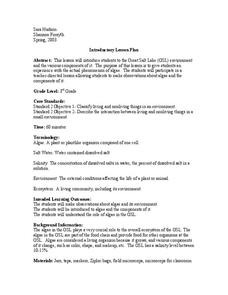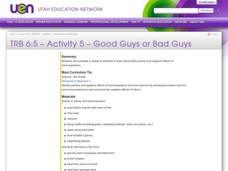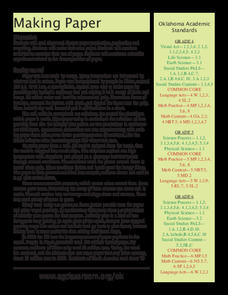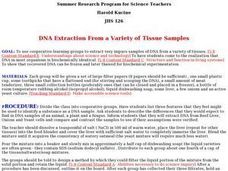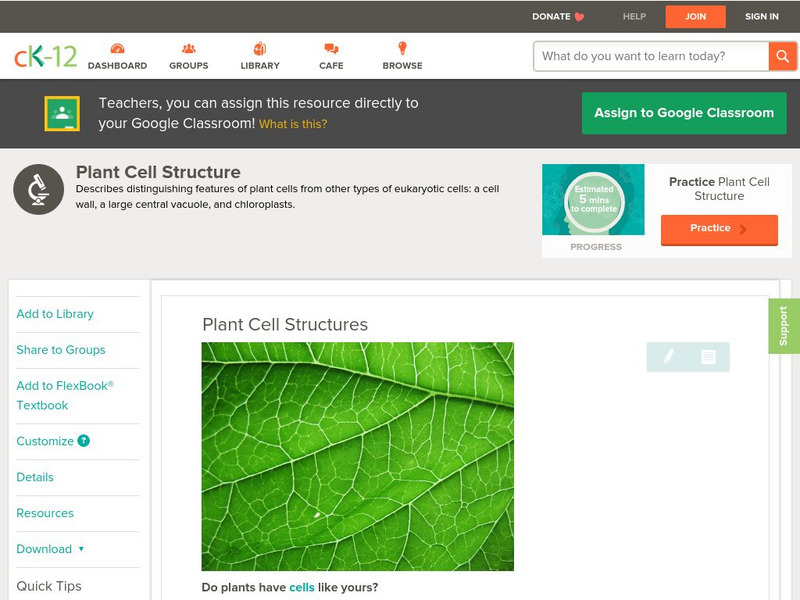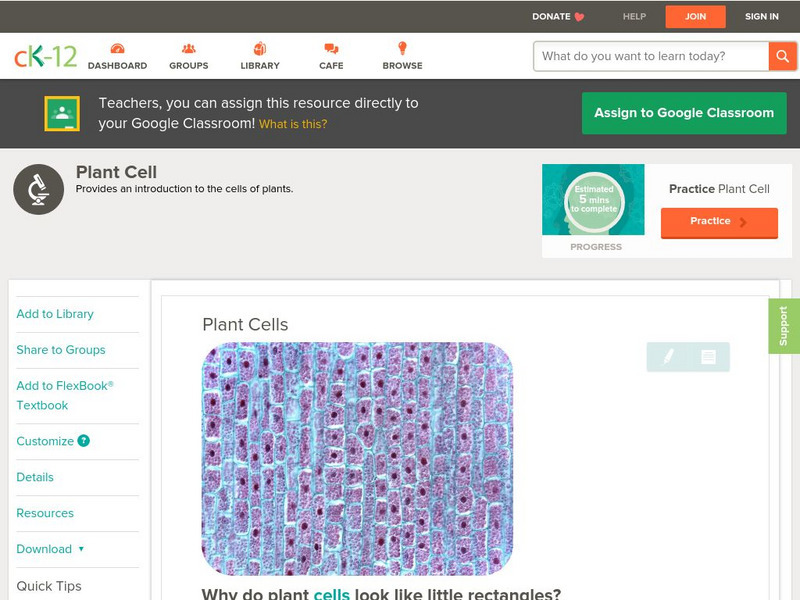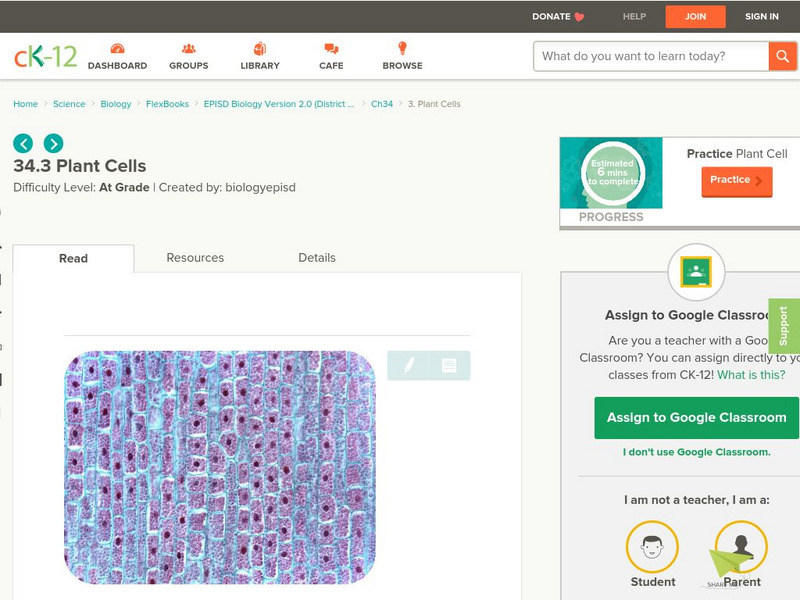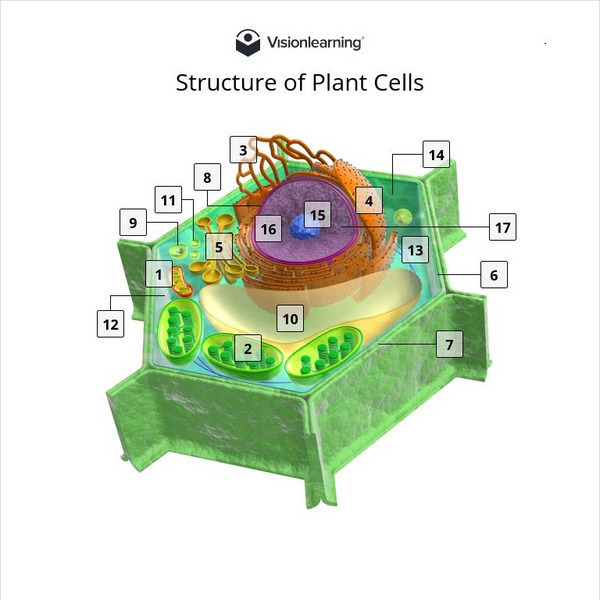Curated OER
The Grass is Always Greener
Third graders experiment with common grass and cellular division.
Curated OER
Goals of the Diversity of Life Unit
Students are introduced to the unit on the importance of diversity of life and the role that interdependence plays in our worlds. this is part of a multi-lesson unit on the diversity of life.
Curated OER
Great Salt Lake
Third graders are introduced to the Great Salt Lake (GSL) environment and the various components of it. They make observations about algae and its environment and discuss why it is considered a living organism and various components of...
Curated OER
LISTENING TO DIRECTIONS
Students view farm objects or products made from farm animals and follow the oral instructions given by the teacher. They are given worksheets, there are three sets of directions for the one worksheet. Students worksheets have everything...
Curated OER
Feedback and Flowcharts
Sixth graders explain what a negative feedback system is and they distinguish it from a positive feedback system. They describe examples of how negative feedback is used in both nature and technology. , Students define homeostasis, and...
Curated OER
Shop projects Summer Smile Program
Students explore the list of products available to make and choose at least 2. In this project lesson students pick and choose their own projects to create in a shop class.
Curated OER
Flower Pigments
Students experiment with Thin Layer Chromatography to separate pigments found in flower petals.
Curated OER
Decomposition
Students create a compost pile and chart changes as the materials decompose. Students draw pictures of items placed into their "landfill" and predict how and whether the item will change or not. After two weeks, students write...
Curated OER
Good Guys or Bad Guys
Sixth graders complete a variety of activities to explore both positive and negative effects of microorganisms. They, in groups, engage in a series of experiments which illustrate the effects of certain molds.
Curated OER
Making Paper
Fourth graders investigate the paper usage in their classroom and in other countries by using estimation, counting, and measurement skills. They make paper from recycled paper.
Curated OER
Different Types of Orange Juice Contain the Same Amounts of Vitamin C?
High schoolers measure and compare the amount of vitamin C in orange juice samples. They discover the effects of different factors on the concentration of vitamin C. They participate in an experiment to test the orange juice.
Curated OER
DNA Extraction From a Variety of Tissue Samples
Learners, working in cooperative groups, extract very impure samples of DNA from a number of tissue samples. They determine how the samples can be preserved and how they are similar.
Curated OER
Making Paper
Students make paper from recycled paper. The student estimates, counts, and measures he amount of paper consumed in a classroom daily. They discover that if we use too much paper, it fills up landfills. Some activities they are doing...
Curated OER
Algae
In this biology learning exercise, learners identify and locate various vocabulary terms pertaining to algae. There are 54 biology terms located in the word search.
Curated OER
Wandering Wild-oats
Students observe wild-oat seeds. In this biology lesson, students watch how wild-oat seeds react to moisture and draw conclusions and make predictions.
Curated OER
Recycling Vocabulary Fill Puzzle
In this recycling vocabulary worksheet, students use a set of recycling definition clues to complete a crossword puzzle. A reference web site is given for additional activities.
Curated OER
Types of Reactions
In this reactions worksheet, students describe combustion as either exothermal or endothermal. Students balance reactions and label the types of reactions. This worksheet has 1 multiple choice, 2 short answer, and 10 problem solving...
PBS
Pbs Learning Media: Animal and Plant Cell
Think you can tell a yam from a yak? Examine these still images of typical plant and animal cells from Biology by Kenneth R. Miller and Joseph Levine. What similarities and differences can you find?
CK-12 Foundation
Ck 12: Life Science: Plant Cell Structures
[Free Registration/Login may be required to access all resource tools.] Even though plants and animals are both eukaryotes, plant cells differ in some ways from animal cells. Plant cells have a large central vacuole, are surrounded by a...
CK-12 Foundation
Ck 12: Biology: Plant Cells
[Free Registration/Login may be required to access all resource tools.] Overview of plant cells and the unique structures found in plants cells only.
Science Education Resource Center at Carleton College
Serc: Animal and Plant Cell Models and Cell Tour Given to Life Science Students
A biology class is divided into two groups: one an animal cell, and the other one, a plant cell. They are given a list of cell organelles to research and construct in their 9 M X 9 M model. Students must organize and assign duties,...
Enchanted Learning
Enchanted Learning: Plant Cell: Animal Cell Anatomy
This is a thorough site which contains a glossary of plant/animal cell anatomy terms. Diagrams of both cells are included along with worksheets to label.
CK-12 Foundation
Ck 12: Episd: Plant Cells
[Free Registration/Login may be required to access all resource tools.] Recognize the structure of a plant cell and understand how each part works.
Vision Learning
Visionlearning: Structure of Plant Cells
An interactive plant cell that presents labels and definitions of the different cell parts when selected.
Other popular searches
- Plant Cell Biology
- Plant Cell Diagram
- Animal and Plant Cells
- Plant Cell Illustrations
- Specialized Plant Cells
- Animal Cells Plant Cells
- Plant Cell Structure
- Plant Cell Parts
- Animals and Plant Cells
- Animal & Plant Cells
- Compare Plant Animal Cells
- Animal Plant Cells


